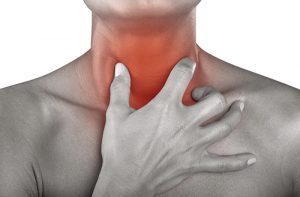The process of swallowing consists of three phases. The oral phase is the process of sucking, chewing and moving food or liquid from the mouth toward the throat. The pharyngeal phase is the start of the swallowing reflex when food is squeezed into the throat and the airway is closed to prevent choking. The esophageal phase is the relaxing and tightening of the openings at the top and bottom of the esophagus (feeding tube) and the movement of the food into the stomach. A swallowing disorder can occur at any of these phases.
Some symptoms of a swallowing disorder include coughing during or after eating or drinking, gurgling of the voice after eating or drinking, expending extra effort to chew or swallow, leaking food or liquid out of the mouth and feeling congested in the chest after eating or drinking. As a result of these symptoms, those suffering severely from a swallowing disorder may be malnourished or chronically dehydrated, at risk for choking or developing pneumonia and may feel embarrassed or isolated in social situations involving eating and drinking.
In adults, there are many causes for swallowing disorders. Sometimes they are caused by damage to the nervous system such as from a stroke, spinal or brain injury, Parkinson’s disease, multiple sclerosis, ALS, cerebral palsy, muscular dystrophy or Alzheimer’s disease. They can also be caused by gastroesophageal reflux, cancer in the mouth or throat, injury or surgery of the head or neck and dental issues like decayed or missing teeth and poorly fitting dentures.
Therapy with a speech-language pathologist (SLP) is often a recommended treatment for swallowing disorders. SLPs can teach patients specific exercises to improve muscle movements, positions or strategies to make swallowing easier and recommend specific foods that may be easiest and safest to swallow.
Reflux
 Acid reflux disease is a condition wherein the stomach contents travel back up the esophagus due to the lower esophageal sphincter (LES) not contracting over the stomach valve after swallowing. Common symptoms include tasting acid in the back of the mouth, heartburn, bad breath, a lump sensation in the throat, breathing problems and eroding teeth. Symptoms of acid reflux may be relieved by avoiding lying down for several hours after eating, avoiding certain foods, losing weight and quitting smoking. If symptoms still persist, medication or surgery may be necessary. For more information, please visit: entnet.org
Acid reflux disease is a condition wherein the stomach contents travel back up the esophagus due to the lower esophageal sphincter (LES) not contracting over the stomach valve after swallowing. Common symptoms include tasting acid in the back of the mouth, heartburn, bad breath, a lump sensation in the throat, breathing problems and eroding teeth. Symptoms of acid reflux may be relieved by avoiding lying down for several hours after eating, avoiding certain foods, losing weight and quitting smoking. If symptoms still persist, medication or surgery may be necessary. For more information, please visit: entnet.org
FEES
Fiberoptic endoscopic evaluation of swallowing (FEES) is a procedure where a doctor assesses the body’s swallowing mechanisms by inserting a small, flexible telescope through the nose to observe the swallowing mechanism. The procedure is performed by providing local anesthesia to the patient, inserting a telescope through the nose and giving various foods to the patient for them to eat. The doctor is then able to observe and evaluate the swallowing process to determine if and where the swallowing disorder takes place.
Dry Mouth/Throat
Our bodies produce saliva to moisten and cleanse our mouths, to fight infections and to help us digest food. When we don’t produce enough saliva, a common symptom is dry mouth and throat. Dry mouth is often caused by medication side effects, nerve damage, dehydration, infections, other diseases and tobacco use. Treating dry mouth may require evaluation from a doctor to first determine the underlying cause.
Burning Mouth
A burning, tickling or numbness in the mouth can have many causes including allergies to metals or foods, dry mouth, diabetes, neurological problems, certain medications (such as blood pressure medications), nutritional deficiencies, infection and acid reflux. Treatments for burning mouth include treating the underlying cause, taking medications, staying hydrated, changing medications, chewing sugarless gum and avoiding irritating substances. Talk to your doctor to determine the cause of your burning mouth and possible treatment options.
Zenker’s Diverticulum
Zenker’s diverticulum refers to an abnormal pouch or swelling of the mucus membrane of the pharynx. In other words, it is when excessive pressure in the lower pharynx causes the pharyngeal walls to balloon out several centimeters in diameter. This can cause difficulty swallowing, regurgitation, cough, bad breath, infection and trap food and debris. Severe cases may necessitate neck surgery to correct the muscle’s position.
